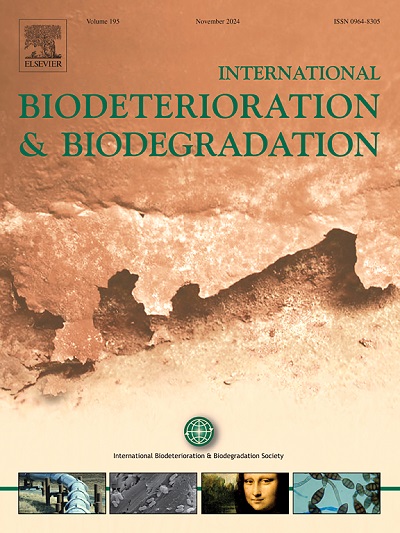The chemolithoautotrophic bacterium CB1MN can utilize hydrogen and sulfur as electron donors with ferric iron as electron acceptor
IF 4.1
2区 环境科学与生态学
Q2 BIOTECHNOLOGY & APPLIED MICROBIOLOGY
International Biodeterioration & Biodegradation
Pub Date : 2025-02-01
DOI:10.1016/j.ibiod.2024.105988
引用次数: 0
Abstract
Microbially mediated redox processes of sulfur compounds are closely related to the occurrence of iron oxides in natural ecosystems. However, so far, no pure culture has been reported to couple sulfur oxidation to iron reduction under neutral or alkaline conditions. Here, we report on a pure culture of a sulfur-oxidizing and iron-reducing bacterium (strain CB1MN) and demonstrate that hydrogen can be used as an electron donor supporting the growth of strain CB1MN with ferrihydrite as electron acceptor. The reduction of ferrihydrite by CB1MN produced dissolved Fe(II) and secondary minerals, which was confirmed by Raman analysis. In addition, strain CB1MN can also utilize a few organic carbon and electron sources such as glucose, pyruvate, acetate, and succinate for maintaining growth and metabolic activity with sulfite as electron acceptor. Genomic analysis showed that a membrane-bound Hyd-4-type hydrogenase and a cytoplasmic F420-non-reducing hydrogenase should be responsible for the hydrogen oxidation. Furthermore, a large number of genes encoding type IV pili and flagella were suspected to be involved in electron transport. Our results imply that the sulfur- and iron-utilizing chemoautotrophs not only use sulfur compounds for energy conservation, but hydrogen and organic carbon sources can be electron donors.

趋化石自养细菌CB1MN可以利用氢和硫作为电子给体,铁作为电子受体
微生物介导的硫化合物氧化还原过程与自然生态系统中氧化铁的发生密切相关。然而,到目前为止,还没有纯培养在中性或碱性条件下将硫氧化与铁还原结合起来的报道。在这里,我们报道了一种硫氧化和铁还原细菌(菌株CB1MN)的纯培养,并证明氢可以作为支持菌株CB1MN生长的电子供体,以铁水合物为电子受体。用CB1MN还原水合铁产生溶解的Fe(II)和次生矿物,拉曼分析证实了这一点。此外,菌株CB1MN还可以利用葡萄糖、丙酮酸、乙酸、琥珀酸等几种有机碳和电子源,以亚硫酸盐为电子受体维持其生长和代谢活性。基因组分析表明,膜结合的氢-4型氢化酶和细胞质的f420 -非还原性氢化酶应该负责氢氧化。此外,大量编码IV型毛和鞭毛的基因被怀疑参与电子传递。我们的研究结果表明,利用硫和铁的化学自养生物不仅利用硫化合物来节约能源,而且氢和有机碳源也可以成为电子供体。
本文章由计算机程序翻译,如有差异,请以英文原文为准。
求助全文
约1分钟内获得全文
求助全文
来源期刊
CiteScore
9.60
自引率
10.40%
发文量
107
审稿时长
21 days
期刊介绍:
International Biodeterioration and Biodegradation publishes original research papers and reviews on the biological causes of deterioration or degradation.

 求助内容:
求助内容: 应助结果提醒方式:
应助结果提醒方式:


